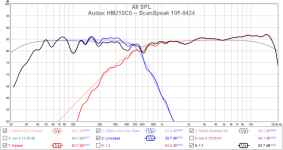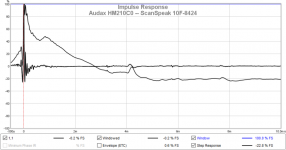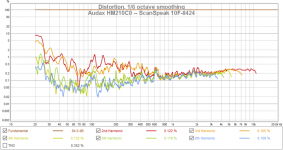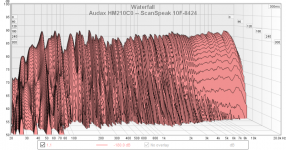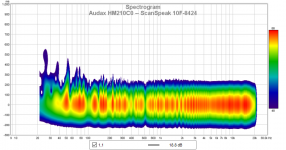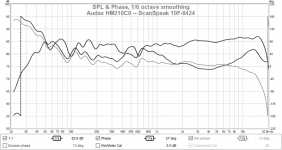Bob,
I enjoyed listening to your FAST speakers and talking audio talk with you. I was the individual who wants to build a FAST Bib speaker. Your room sounded great. Hope you have good attendance tomorrow.
I enjoyed listening to your FAST speakers and talking audio talk with you. I was the individual who wants to build a FAST Bib speaker. Your room sounded great. Hope you have good attendance tomorrow.
Ok. Back from LSAF and had some time to contemplate.
The real downside of this year's show was the complete lack of DIY exibitors. The bulk of the rooms were equipment in the mid to high priced range that is well beyond the average guy. I am sure that sales were next to nil. (BTW, I have never in the now, what 10 years? that I have been doing this show sold one dime of speakers, kits or plans.
Hotel rooms are a tough venue to get decent sound in. The rooms have an 18dB resonance at 43Hz. Some guys made modest efforts to passively correct the rooms, but it didn't work well. They all wound up with fat bass. Now active room correction is not a great answer, but it can work if you limit the listening area. I put a mic in the middle seat of the sofa and put a 16dB hole in the bass response. No room boom. At least for those sitting on the sofa.
Space heaters were all the rage at the show. At least 3/4 of the rooms were running vinyl through tubes. Add the sloppy bass of a SE tube amp to the room boom and bass accuracy was not the order of the day. I was reading the flier for a $6500 2A3 SE amp that had a note that if over-escursion was a problem, there is a switch that adds negative feedback to the amp. Talk about designed in problems!
There were a half dozen OB speakers at the show. They ranged from godawful to one of the best speakers I have ever heard. Most of them had all of the problems that drove me away from OB's: Lousy integration top to bottom, no real bass, nonexistant imaging and that comes-from-everywhere midrange. But then there was Manzanita Audio Solutions. John uses a 21" bass driver, and IIRC a 15" full-range. As John explained, once the bass driver unloads, the speaker becomes a monopole. No room modes and decent imaging. Yes OB can be done right, but not with a 3" driver and a sheet of plywood.
More on my contribution to LSAF 2016 later.
Bob
The real downside of this year's show was the complete lack of DIY exibitors. The bulk of the rooms were equipment in the mid to high priced range that is well beyond the average guy. I am sure that sales were next to nil. (BTW, I have never in the now, what 10 years? that I have been doing this show sold one dime of speakers, kits or plans.
Hotel rooms are a tough venue to get decent sound in. The rooms have an 18dB resonance at 43Hz. Some guys made modest efforts to passively correct the rooms, but it didn't work well. They all wound up with fat bass. Now active room correction is not a great answer, but it can work if you limit the listening area. I put a mic in the middle seat of the sofa and put a 16dB hole in the bass response. No room boom. At least for those sitting on the sofa.
Space heaters were all the rage at the show. At least 3/4 of the rooms were running vinyl through tubes. Add the sloppy bass of a SE tube amp to the room boom and bass accuracy was not the order of the day. I was reading the flier for a $6500 2A3 SE amp that had a note that if over-escursion was a problem, there is a switch that adds negative feedback to the amp. Talk about designed in problems!
There were a half dozen OB speakers at the show. They ranged from godawful to one of the best speakers I have ever heard. Most of them had all of the problems that drove me away from OB's: Lousy integration top to bottom, no real bass, nonexistant imaging and that comes-from-everywhere midrange. But then there was Manzanita Audio Solutions. John uses a 21" bass driver, and IIRC a 15" full-range. As John explained, once the bass driver unloads, the speaker becomes a monopole. No room modes and decent imaging. Yes OB can be done right, but not with a 3" driver and a sheet of plywood.
More on my contribution to LSAF 2016 later.
Bob
What are prices "beyond" ?
$6500 monoblocks. $3000 turntables. $1000 cables. $10000 speakers.
I'd like to hear what people thought of your speakers Bob.
Give me a couple of days. I will continue the thread.
Bob
Ah. I thought my 12" full range sounded good at high volumes perhaps due to less sound going everywhere. Makes sense.
I finally got some time to play with the cross-over for my Audax/SS FAST speaker. I wanted to keep the XO below the telephone band so I placed the XO at 300Hz, however, this is just not possible with a 3" class driver. The 300Hz XO did work quite well at the Dallas show, but the 10F was working way too low and that shows in the distortion plots at high SPL. So I tried again, this time at 500Hz. The natural roll-off of the 10F still shows in the tail of the high pass, but it is now significantly lower in frequency and the driver is not working nearly as hard.
I included the target plots that Byrtt provided and I got a reasonably good match. As it turns out, level matching the drivers is extremely important to getting an acceptable FR plot once the tweeter is time delayed. I wound up lowering the tweeter 1.5dB, which is why the tail doesn't match the target exactly.
Trying to get decent low frequency data in a home environment is next to impossible, so I did not try to smooth out the woofer FR, I just made the tail match the target. This is good enough. Trying to take the room modes out a 1m is pointless since the room modes at the listening chair are totally different. My technique is to use the "output" PEQ's to tailor the low pass tail, then use the "input" PEQ's to handle the room modes from the listening chair.
These speakers have the cleanest sound of any I have built. The main reason is that the two drivers have very low distortion. Except for a very few minor peaks, the distortion stays below 1% until below 30Hz. While my drivers cost twice what the drivers in the other XO thread currently running, you do get what you pay for. There is no comparison in the distortion plots. Will my speakers sound twice as good? Probably not, and the sound of the FF85WK is very different from the sound of the 10F, but still....
It is unfortunate that I rushed the cabinets to completion to make the Dallas show. I did a rather poor job of the veneer and finish, so these cabinets are destined for the fire pit. The replacement will likely be a three-way: Dayton RSS315HF-4 16-80Hz, Audax HM210C0 80-500Hz, ScanSpeak 10f-8424 500Hz up. I might even gild the lily with a rear firing super tweeter crossed with a single cap at what? 20kHz? I'll never here it, but hey!
Bob
I included the target plots that Byrtt provided and I got a reasonably good match. As it turns out, level matching the drivers is extremely important to getting an acceptable FR plot once the tweeter is time delayed. I wound up lowering the tweeter 1.5dB, which is why the tail doesn't match the target exactly.
Trying to get decent low frequency data in a home environment is next to impossible, so I did not try to smooth out the woofer FR, I just made the tail match the target. This is good enough. Trying to take the room modes out a 1m is pointless since the room modes at the listening chair are totally different. My technique is to use the "output" PEQ's to tailor the low pass tail, then use the "input" PEQ's to handle the room modes from the listening chair.
These speakers have the cleanest sound of any I have built. The main reason is that the two drivers have very low distortion. Except for a very few minor peaks, the distortion stays below 1% until below 30Hz. While my drivers cost twice what the drivers in the other XO thread currently running, you do get what you pay for. There is no comparison in the distortion plots. Will my speakers sound twice as good? Probably not, and the sound of the FF85WK is very different from the sound of the 10F, but still....
It is unfortunate that I rushed the cabinets to completion to make the Dallas show. I did a rather poor job of the veneer and finish, so these cabinets are destined for the fire pit. The replacement will likely be a three-way: Dayton RSS315HF-4 16-80Hz, Audax HM210C0 80-500Hz, ScanSpeak 10f-8424 500Hz up. I might even gild the lily with a rear firing super tweeter crossed with a single cap at what? 20kHz? I'll never here it, but hey!
Bob
Attachments
The replacement will likely be a three-way: Dayton RSS315HF-4 16-80Hz, Audax HM210C0 80-500Hz, ScanSpeak 10f-8424 500Hz up. I might even gild the lily with a rear firing super tweeter crossed with a single cap at what? 20kHz? I'll never here it, but hey!
Bob
That's going to be a big speaker box... 🙂
All active system?
I finally got some time to play with the cross-over for my Audax/SS FAST speaker. I wanted to keep the XO below the telephone band so I placed the XO at 300Hz, however, this is just not possible with a 3" class driver. The 300Hz XO did work quite well at the Dallas show, but the 10F was working way too low and that shows in the distortion plots at high SPL. So I tried again, this time at 500Hz. The natural roll-off of the 10F still shows in the tail of the high pass, but it is now significantly lower in frequency and the driver is not working nearly as hard.
I included the target plots that Byrtt provided and I got a reasonably good match. As it turns out, level matching the drivers is extremely important to getting an acceptable FR plot once the tweeter is time delayed. I wound up lowering the tweeter 1.5dB, which is why the tail doesn't match the target exactly.
Trying to get decent low frequency data in a home environment is next to impossible, so I did not try to smooth out the woofer FR, I just made the tail match the target. This is good enough. Trying to take the room modes out a 1m is pointless since the room modes at the listening chair are totally different. My technique is to use the "output" PEQ's to tailor the low pass tail, then use the "input" PEQ's to handle the room modes from the listening chair.
These speakers have the cleanest sound of any I have built. The main reason is that the two drivers have very low distortion. Except for a very few minor peaks, the distortion stays below 1% until below 30Hz. While my drivers cost twice what the drivers in the other XO thread currently running, you do get what you pay for. There is no comparison in the distortion plots. Will my speakers sound twice as good? Probably not, and the sound of the FF85WK is very different from the sound of the 10F, but still....
It is unfortunate that I rushed the cabinets to completion to make the Dallas show. I did a rather poor job of the veneer and finish, so these cabinets are destined for the fire pit. The replacement will likely be a three-way: Dayton RSS315HF-4 16-80Hz, Audax HM210C0 80-500Hz, ScanSpeak 10f-8424 500Hz up. I might even gild the lily with a rear firing super tweeter crossed with a single cap at what? 20kHz? I'll never here it, but hey!
Bob
Nice work Bob. You nailed the Harsch XO right on this time. Sounds great doesn't it? 🙂
Btw, if you ever want to try a lower price point version of this speaker with almost the same sound, the Vifa TG9FD10-8 (white fiberglass cone with 8ohm) works very nicely. It is about 2dB less sensitive than the 10F so won't need that -1.5dB cut and has the same characteristic "fiberglass" sweet smooth mids sound.
They are harder to find though. Used to be $32 at Madisound but see out of stock now.
I found the same issue with distortion which is why I now cross up around 600Hz. The frequency allows use of smaller passive components if I ever wanted to get away from an active speaker.
The other xo thread you refer to with the FF85WK (I assume it's my thread?) is working out nicely. It's not a Harsch so it probably has more woofer bleed through into the mids than I would like so I may add a notch to control that. But here is what I am getting for the distortion and step:

The box has some resonances in the bass obviously that can be improved. But the flatness of the response is without any EQ.
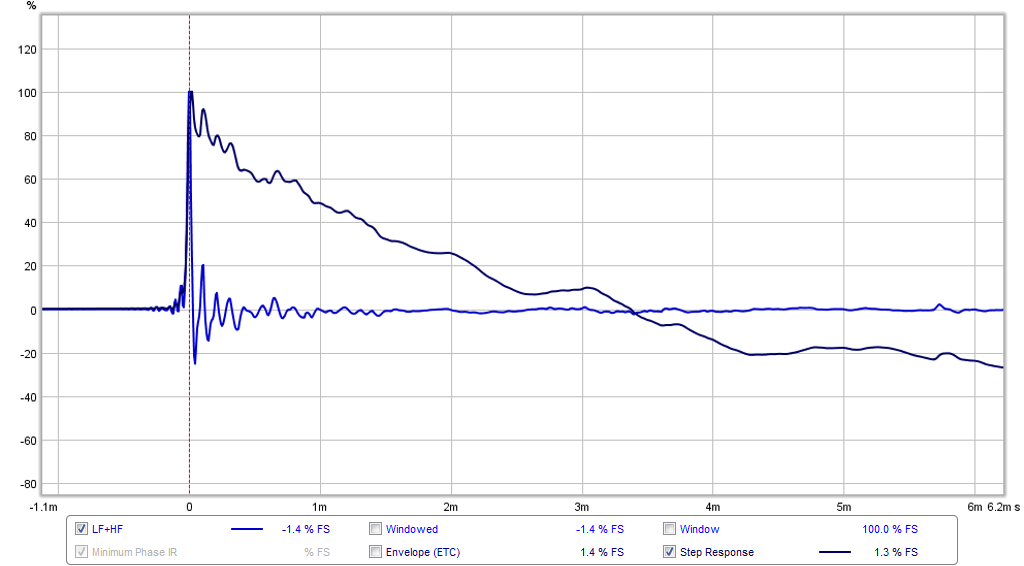
This is all done passively with a first order cap, coil, and resistors.
Last edited:
Nice work Bob. You nailed the Harsch XO right on this time. Sounds great doesn't it? 🙂
Yes it does! A little fat in the mids -- I always seem to have this problem and I wind up cutting the mids 2-3dB. My go to track is Diana Krall "All or Nothing at All". Very difficult track to get right. Another track that is surprisingly difficult to get right is Fleetwood Mac "Never Going Back Again". All acoustic and the mandolin has to be right. Finally, for imaging, I use the Stravinsky "Royal March" from "A Soldier's Tail" off of the Chesky "Ultimate Demonstration Disc". Imaging is rock solid and pinpoint.
Btw, if you ever want to try a lower price point version of this speaker with almost the same sound, the Vifa TG9FD10-8 (white fiberglass cone with 8ohm) works very nicely. It is about 2dB less sensitive than the 10F so won't need that -1.5dB cut and has the same characteristic "fiberglass" sweet smooth mids sound.
They are harder to find though. Used to be $32 at Madisound but see out of stock now.
I'll put these on the list. I do have a pair of TC9FD NIB. I never did anything with them because they don't go low enough. Perhaps now that I have accepted a higher XO point, they might work. I also have a pair of FF85WK's NIB. Cute little buggers, but they don't have the guts for anything but nearfield. Even at 70dB@2.5m, a 20dB peak requires over 100dB from the driver, and the 85WK's will go into dynamic compression long before that.
The other xo thread you refer to with the FF85WK (I assume it's my thread?) is working out nicely. It's not a Harsch so it probably has more woofer bleed through into the mids than I would like so I may add a notch to control that. But here is what I am getting for the distortion and step:
You are doing that 1st order acoustic, aren't you? When I get a day or two with nothing to do this summer, I intend to set up a series of differen order and slop XO's and give them a listen. It is so easy to do with the miniDSP/nanoDIGI.
The box has some resonances in the bass obviously that can be improved. But the flatness of the response is without any EQ.
As long as the basic driver response is smooth with no significant peaks, chasing room modes is counterproductive. They don't affect the XO and impulse response.
Now that this project is put to bed, I bought a pair of Tang Band W8-2145's. On paper, these look very promising.
Just for grins, here is the phase response of the Audax/SS speaker. Very close to minimum phase.
Bob
Attachments
.....These speakers have the cleanest sound of any I have built. The main reason is that the two drivers have very low distortion. Except for a very few minor peaks, the distortion stays below 1% until below 30Hz.....
Great it sounds build got into a very good speaker system, sense the same thing myself when combining 10F a German Kevlar woofer.
.....Just for grins, here is the phase response of the Audax/SS speaker. Very close to minimum phase...
Think that is not for grins but serious good phase response from 2-way IRR speaker system, could even imagine if you push button "Estimate IR Delay" into REW than phase track above 5kHz would track even closer to that IRR frq-response minimum phase ideal, thanks sharing nice speaker and data.
Hi Bob,
Thank you for sharing this design.
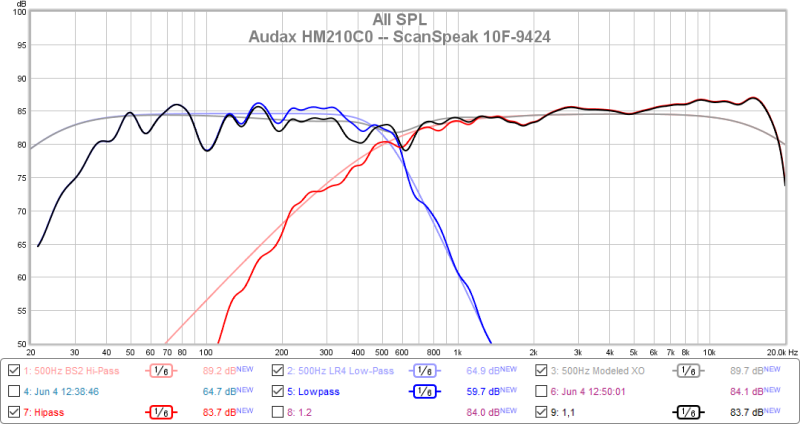
One thing caught my eye: look at the region from about 200 Hz to 1000 Hz. The sum of both drivers should be greater than the individual responses everywhere in that region. Currently, in some places the sum is below the individual driver responses. This indicates that the phase of the individual drivers is not overlapping in this region. What this means is that as you move up and down from the midpoint of the two drivers, you will get peaks and nulls at different frequencies.
Check out this thread for more information. It is a treasure trove:
Crossover mods for the AR4x - Mods, Tweaks, and Upgrades to the Classics - The Classic Speaker Pages Discussion Forums
HolmImpulse is fantastic for designing crossovers because you can quickly tell what's happening with the phase. Once you get good phase overlap through the crossover, it will sound seamless, like one driver, and you will not be able to tell where the crossover is.
Thank you for sharing this design.

One thing caught my eye: look at the region from about 200 Hz to 1000 Hz. The sum of both drivers should be greater than the individual responses everywhere in that region. Currently, in some places the sum is below the individual driver responses. This indicates that the phase of the individual drivers is not overlapping in this region. What this means is that as you move up and down from the midpoint of the two drivers, you will get peaks and nulls at different frequencies.
Check out this thread for more information. It is a treasure trove:
Crossover mods for the AR4x - Mods, Tweaks, and Upgrades to the Classics - The Classic Speaker Pages Discussion Forums
HolmImpulse is fantastic for designing crossovers because you can quickly tell what's happening with the phase. Once you get good phase overlap through the crossover, it will sound seamless, like one driver, and you will not be able to tell where the crossover is.
Ra7,
Bob is using the Harsch XO - a characteristic of it is that the sum is less than the bass by itself. That's actually how you know it's working. Best way is to look at phase plot. It will be approximately flat with a soft rise by 55 deg at the xo frequency. The response actually oscillates by about 1dB through the xo region. That's normal.
http://www.diyaudio.com/forums/multi-way/277691-s-harsch-xo.html
Here is theoretically what it should look like - notice the squiggles and how it's less than woofer by itself?
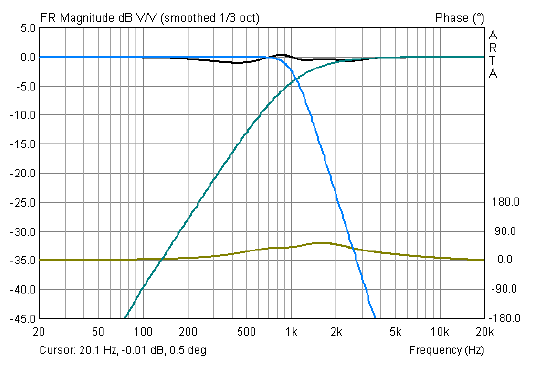
Bob is using the Harsch XO - a characteristic of it is that the sum is less than the bass by itself. That's actually how you know it's working. Best way is to look at phase plot. It will be approximately flat with a soft rise by 55 deg at the xo frequency. The response actually oscillates by about 1dB through the xo region. That's normal.
http://www.diyaudio.com/forums/multi-way/277691-s-harsch-xo.html
Here is theoretically what it should look like - notice the squiggles and how it's less than woofer by itself?

I will post in the XO thread, not here, about the Harsch XO. Why would you optimize for parameters other than the frequency response? Not only will there be ripples on-axis, but similarly uneven performance will manifest on other axes. This is a very poor trade-off to get an improved step response.
Not a poor trade off at all in my opinion - if transient perfect or quasi transient perfect is important to you. Once you hear it - second order LR with upside down tweeter sounds not so good anymore for percussion and plucked strings when source is recorded well. What's 1dB of ripple? The phase is linear with a mild rise - that's better than a phase wrap going through 180deg.
@ra7
1. Have you actual heard a transient perfect XO? Listen to the difference in makes in attacks.
2. I could care less about off axis, as this is a single listener system. I only care about how it sounds at my chair.
3. You will never hear hear the minor ripples. Remember that your brain fills in voids, and there are no peaks in this XO.
Bob
1. Have you actual heard a transient perfect XO? Listen to the difference in makes in attacks.
2. I could care less about off axis, as this is a single listener system. I only care about how it sounds at my chair.
3. You will never hear hear the minor ripples. Remember that your brain fills in voids, and there are no peaks in this XO.
Bob
After ra7 comments have posted some concerning data over http://www.diyaudio.com/forums/multi-way/277691-s-harsch-xo-28.html#post4742794
Hi Byrtt,
Thanks for the nice visual study using actual electrical data generated by your DSP simulator. Very apparent now that waterfall is cleaner - never knew that before.
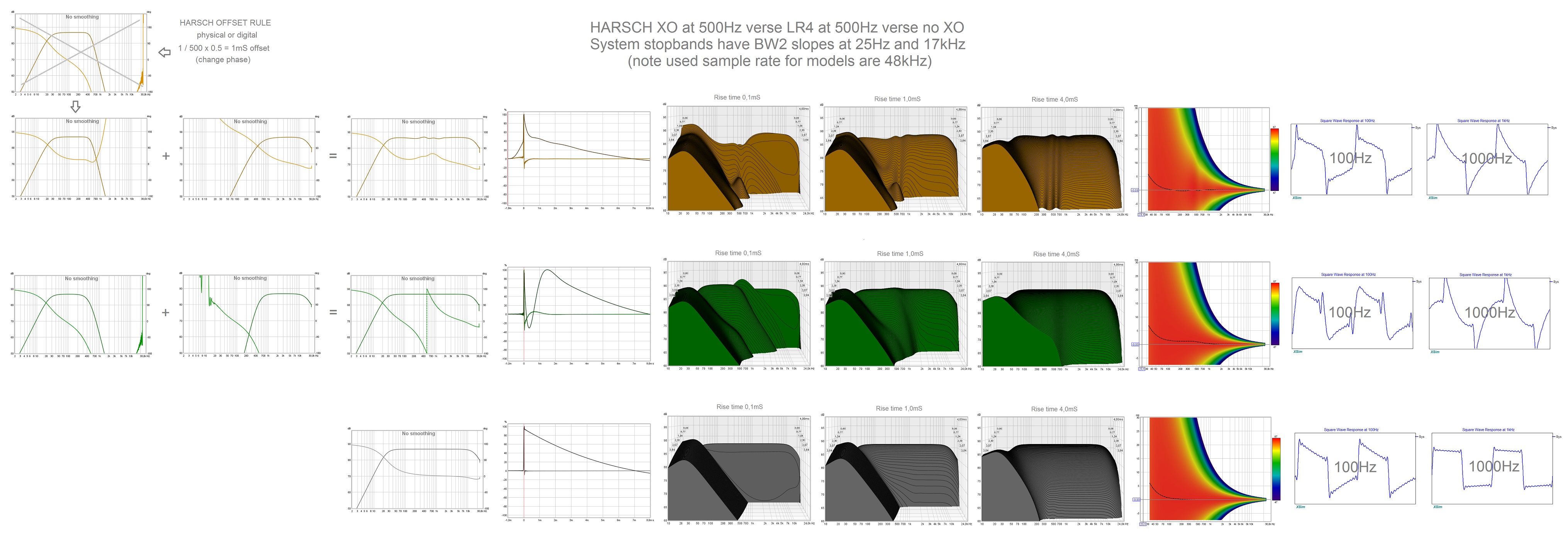
Thanks for the nice visual study using actual electrical data generated by your DSP simulator. Very apparent now that waterfall is cleaner - never knew that before.

Hi Byrtt,
Thanks for the nice visual study using actual electrical data generated by your DSP simulator. Very apparent now that waterfall is cleaner - never knew that before.
Yes having less time lag caused by XO points gives cleaner waterfall for direct first wave front and is welcome plus should be possible to hear as an listenable improvement that get one a bit closer into tracks record room, and then comes also the bit better transients that Harsch offer that many observe and feel as giving better realism on attacks. Harsch XO setup is a little bit to speedy at some frq as can be seen in dip at waterfall with 0,1mS rise time and also spectrogram show where frq is ahead in time and therefor not presented into waterfall.
Hi Bob,
Any thoughts on the Tang Band W8-2145's so far, looks like a good lower cost alternative to some of the other 8 inch full range options.
Larry
Any thoughts on the Tang Band W8-2145's so far, looks like a good lower cost alternative to some of the other 8 inch full range options.
Larry
@larry,
Haven't run them yet. They are not exactly a drop-in for either the 1772 or the 1808. The ferrite 2145 has much less flux power as demonstrated by the hugely larger Qts. The 2145 also does not have the rising response of the neo drivers. It takes a big box -- 100l vented , 70l MLTL, 45l sealed. A tapered TL may be the best bet.
Bob
Haven't run them yet. They are not exactly a drop-in for either the 1772 or the 1808. The ferrite 2145 has much less flux power as demonstrated by the hugely larger Qts. The 2145 also does not have the rising response of the neo drivers. It takes a big box -- 100l vented , 70l MLTL, 45l sealed. A tapered TL may be the best bet.
Bob
- Status
- Not open for further replies.
- Home
- Loudspeakers
- Full Range
- What I am taking to LSAF
